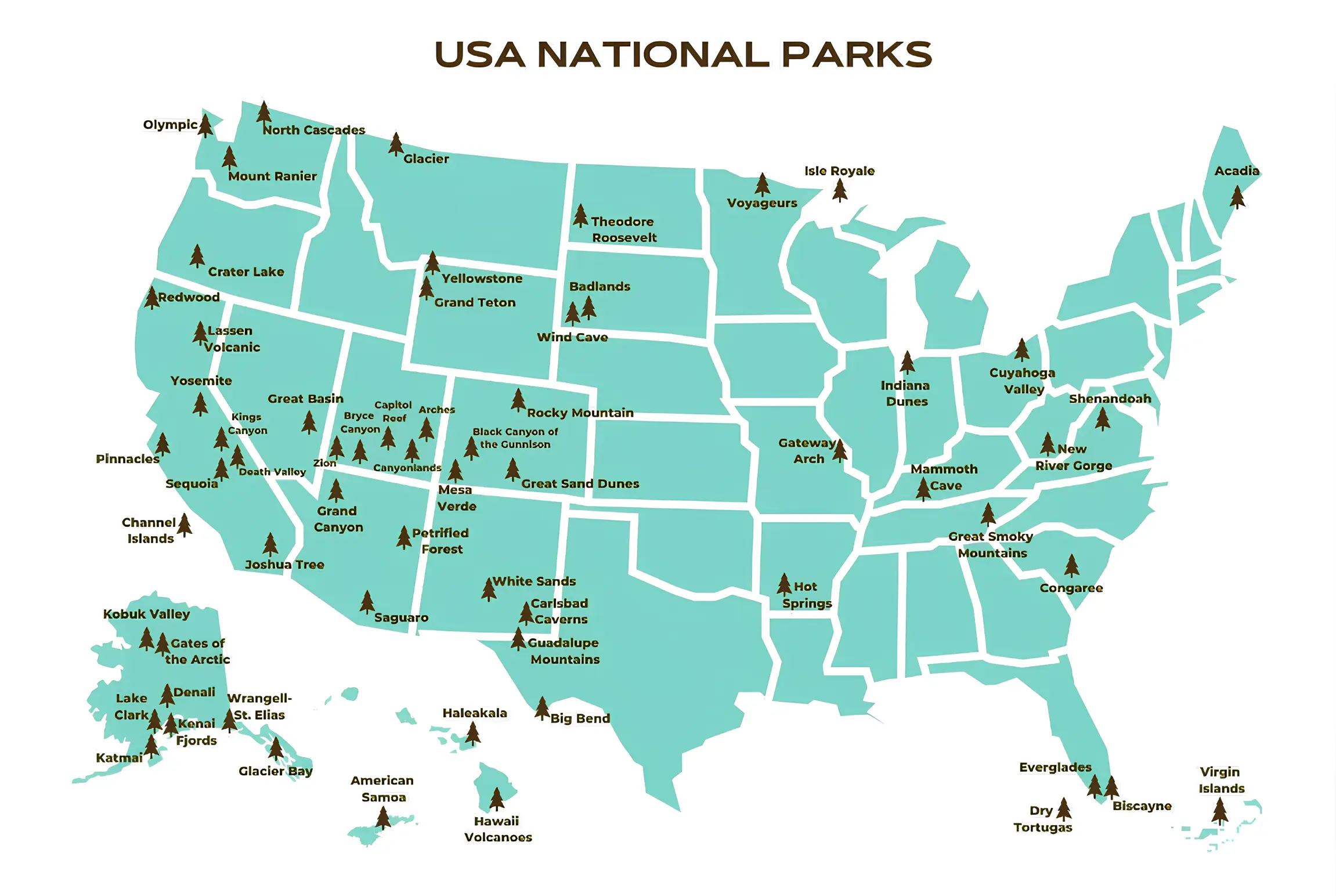US National Parks
The United States National Park System includes 63 protected areas designated as national parks, often called "America's Best Idea." These parks preserve the nation's most spectacular natural wonders, diverse ecosystems, and significant historical sites for future generations.
From the towering peaks of Denali to the deep canyons of the Grand Canyon, from the vast wilderness of Yellowstone to the underwater wonders of Biscayne, these parks represent the incredible diversity of American landscapes. They serve as sanctuaries for wildlife, repositories of natural history, and destinations for millions of visitors each year.
The National Park Service, established in 1916, manages these parks along with hundreds of other protected sites. The first national park was Yellowstone, established in 1872, while the newest is New River Gorge, designated in 2020.
National Parks Map
U.S. National Parks aren’t evenly spread. The West is packed. California and Utah cluster many icons (Yosemite, Zion, Bryce), while Alaska holds vast, remote parks like Denali and Wrangell–St. Elias.
Rockies & Southwest concentrate variety. From red-rock arches and slot canyons to high alpine peaks and the towering dunes of Great Sand Dunes. The Midwest and Great Plains have fewer parks. But standouts such as Badlands and Gateway Arch protect unique prairie and cultural landscapes.
The East features forested mountains: Great Smoky Mountains, Shenandoah, and Acadia—plus Florida’s water-world of Everglades, Biscayne, and Dry Tortugas. Beyond the mainland expands the story with Hawai‘i Volcanoes, Haleakalā, American Samoa’s rainforests, and the Virgin Islands’ coral reefs.

National Parks Directory
Acadia
Maine
American Samoa
American Samoa
Arches
Utah
Badlands
South Dakota
Big Bend
Texas
Biscayne
Florida
Black Canyon of the Gunnison
Colorado
Bryce Canyon
Utah
Canyonlands
Utah
Capitol Reef
Utah
Carlsbad Caverns
New Mexico
Channel Islands
California
Congaree
South Carolina
Crater Lake
Oregon
Cuyahoga Valley
Ohio
Death Valley
California, Nevada
Denali
Alaska
Dry Tortugas
Florida
Everglades
Florida
Gates of the Arctic
Alaska
Gateway Arch
Missouri
Glacier
Montana
Glacier Bay
Alaska
Grand Canyon
Arizona
Grand Teton
Wyoming
Great Basin
Nevada
Great Sand Dunes
Colorado
Great Smoky Mountains
Tennessee, North Carolina
Guadalupe Mountains
Texas
Haleakalā
Hawaii
Hawai'i Volcanoes
Hawaii
Hot Springs
Arkansas
Indiana Dunes
Indiana
Isle Royale
Michigan
Joshua Tree
California
Katmai
Alaska
Kenai Fjords
Alaska
Kings Canyon
California
Kobuk Valley
Alaska
Lake Clark
Alaska
Lassen Volcanic
California
Mammoth Cave
Kentucky
Mesa Verde
Colorado
Mount Rainier
Washington
New River Gorge
West Virginia
North Cascades
Washington
Olympic
Washington
Petrified Forest
Arizona
Pinnacles
California
Redwood
California
Rocky Mountain
Colorado
Saguaro
Arizona
Sequoia
California
Shenandoah
Virginia
Theodore Roosevelt
North Dakota
Virgin Islands
U.S. Virgin Islands
Voyageurs
Minnesota
White Sands
New Mexico
Wind Cave
South Dakota
Wrangell-St. Elias
Alaska
Yellowstone
Wyoming, Montana, Idaho
Yosemite
California
Zion
Utah
Quick Facts About US National Parks
Oldest Park
Yellowstone
(1872)
Newest Park
New River Gorge
(2020)
Largest Park
Wrangell-St. Elias
13.2M acres
Smallest Park
Gateway Arch
91 acres
Most Visited
Great Smoky Mountains
14.1M visitors/year
Least Visited
Gates of the Arctic
~10K visitors/year
Deepest Lake
Crater Lake
1,943 feet
Highest Point
Denali
20,310 feet
Lowest Point
Death Valley
-282 feet
States Without Parks
15 states
have no National Parks